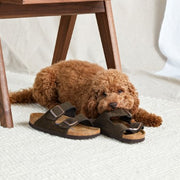- Home
- -
- Foot Health and Happiness
- -
- Birkenstock Soft Footbed vs Regular Footbed - Which Is Better For You?
Birkenstock Soft Footbed vs Regular Footbed - Which Is Better For You?
August 05, 2021

What are the materials and layers that make up the Birkenstock Footbeds?
The traditional Birkenstock footbed is composed of 4 different layers, which are all super important in providing that comfort we know and love.
- Firstly, there is a layer of jute that connects to the EVA soles. The jute provides a flexible and solid base for the footbed during construction and helps to adhere the EVA to the footbed.
- The second layer is a cork and natural latex mix. The premium cork used is lightweight, strong and shock absorbent which is the perfect material for the contoured Birkenstock design, and the latex helps bind the cork together while still being soft enough to allow the bed to shape to your unique foot.
- Thirdly, there is another jute layer on top of the cork/latex layer. Jute is great not only because it’s renewable, but also because it is durable and flexible so that as the footbed changes shape with your foot it remains intact and strong.
- Lastly, your foot is hugged by a suede lining that is soft and comfortable under your foot. If you were to order a Vegan style, the suede lining is swapped out for a cruelty-free microfibre lining.

So how is the Soft Footbed different?
The soft Footbed style introduces another layer into the structure of the Birkenstock. We call this the fifth layer, although it sits between the third and fourth layers.
This is an extra layer of latex, which makes the footbed feel much softer underfoot. The latex helps to reduce the height of the arch for those who have flat arches so when you’re breaking these in they’re less painful. They’re also soft, and spongier under your foot. It feels like walking on a cloud.
Should I buy the Soft Footbed style or am I better off with the Traditional style?
It really depends on your specific foot needs as to which footbed is best for you. Most people can wear either type, you lucky ducks. However, if you do have some foot complaints there are some pros and cons for either style.
If you have high arches that don’t collapse, the traditional footbed is the one for you. This is because the footbed will touch the underneath of your arch and support you throughout the day. If you have arches that collapse, you may feel like the arch presses quite harshly into your foot as it is trying to lift you back up into the proper position. If you have sensitive feet this may be an uncomfortable adjustment for you. You can still wear this style but wear them in very slowly so you can adjust to the arch. We recommend wearing them for no more than 1-2 hours for the first 2-3 weeks which we suggest for all wearers.
If you have plantar fasciitis, you can wear either style. Your choice will depend on how painful your condition is, or how tight your fascia is. If you have a very tight or painful fascia, you will do better in a soft footbed as this is a gentler wearing in process and helps your condition improve by supporting your tight fascia.
If you get plantar fasciitis pain when you do not have total contact with your footbed, you will find the traditional footbed better suited to your needs.
Our general recommendation is that if you have ongoing pain in your feet, the soft footbed is the way to go as this is gentle to wear in. Otherwise, you should have no issues with the traditional footbed.


